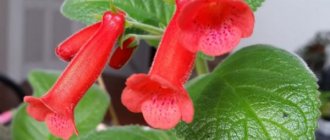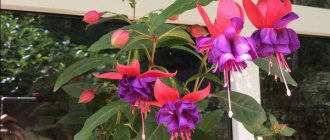Cyclamen persica
Persian cyclamen (Cyclamen persicum) comes from the Mediterranean and northern Africa with hot summers and cool winters. The plant has adapted to such conditions in its own way, grows and blooms in comfortable weather from autumn to spring (there are varieties that bloom in autumn and bloom in winter), and rests in the summer, completely shedding its leaves. In order not to die, cyclamen stores nutrients in a special organ - the tuber (the tuber is the thickened part of the stem under the cotyledon leaves - the hypocotyl).
The undoubted advantage of Persian cyclamen is that it blooms in winter, when there are not many flowering plants. More often it is used once, similar to a bouquet, since Persian cyclamen is an ephemeral plant. Its life cycle is divided into two distinct periods: rest, which lasts up to 9 months, and growth and flowering, which continues the rest of the year. But you can try to save it until the next flowering, which will delight you next winter.
The Dutch company Schoneveld offers the following F1 hybrids of Persian cyclamen: • Super Serie Micro F1 - characterized by a large number of miniature and very long-blooming flowers. There are 17 colors. • Super Serie Verano F1 - in terms of flower size, it belongs to the mini-cyclamen section, designed for growing in warm conditions. 16 colors. • Super Series Compact F1 - characterized by very abundant flowering and long flower life, compact in growth form. 21 colors. • Super Series Da Vinci (Super Serie Da Vinci F1) - has all the qualities of cyclamen Super Series Compact, has silver leaves. 9 colors. • Super Series Mini Winter F1 - specially designed for flowering at the end of the season in the climate of northern Europe, has looser leaves, which ensures better air circulation between the leaves, flowers are not large. 15 colors. • Super Series Picasso (Super Serie Picasso F1) - this series is derived from the Super Series Mini Winter, differs from it in silver leaves. 9 colors. • Super Series Original F1 - medium-sized flowers on a large plant, characterized by very abundant flowering, there are 16 colors, including uneven colors. • Super Serie Allure F1 - medium-sized flowers, the series is specially bred for warm growing, characterized by earlier flowering. 14 colors. • Super Serie Macro F1 - medium flower size on a large plant, characterized by a huge number of flowers with long flowering. 18 colors. • Super Series XL (Super Serie XL F1) - large flowers on large plants, long flowering. 16 colors. • Super Series Michelangelo (Super Serie Michelangelo F1) - mini cyclamen with unique marble leaves, combines the best qualities of the Super Series Compact and Super Series Mini Winter. 9 colors. • Super Series Jive F1 - has elegant wavy petals. 8 bright colors of flowers. • Super Series Mammoth F1 - has beautiful large flowers on a large plant. 8 colors.
Five lines of F1 hybrids offered by the French company Morel:
- Metis® – miniature, hardy and early flowering, with the widest range of shades;
- Tianis® - “midi”, with medium-sized flowers, a very compact habit and a very early onset of flowering;
- Latinia Premium (Latinia® Premium) – with medium-sized flowers, compact habit and early onset of flowering;
- Latinia® - with very large flowers, compact habit and early onset of flowering;
- Halios® – with large flowers, traditional qualities.
There are varieties of another type of cyclamen on sale - purple. Their growing conditions and life cycles differ, so it is important to learn to distinguish these species for proper care . How to distinguish the two types of cyclamen, read the article Purple cyclamen (European).
When buying Persian cyclamen, you should give preference to a plant that has just begun to bloom. This cyclamen has only a few open flowers, and under the leaves there are buds, due to which the flowering will be longer. Peduncles should be strong and stand upright, leaves without signs of yellowness or softness. Be sure to look in the center of the plant to see if there is any gray plaque there (its presence will indicate that the plant is infected with gray rot). The plant should be moderately moist, not overwatered or overdried, with good turgor. Make sure that the tuber partially protrudes above the ground level (this is only necessary for Persian cyclamen). Take care to pack the plant warmly, since in the fall, when it is sold, it is already cold outside.
|
|
The appearance of the plant and its appearance with photos
Cyclamen persica, known to gardeners as alpine violet, is a perennial tuberous-rooted herbaceous plant from the genus Cyclamen of the Marsinaceae family (according to some botanical classifications - Primroses).
Below you will see a photo of Persian cyclamen:
Origin
The homeland of the plant is called the Eastern Mediterranean, but its distribution area is much wider and includes North-East Africa, the Middle East, Spain, and Ukraine.
In Russia, wild varieties of Persian cyclamen can be found on the Caspian and Black Sea coasts, in Crimea, and the Krasnodar Territory.
Historical reference
The Romans were the first to grow Persian cyclamen in their homes and gardens, to whom it owes its spread as a houseplant throughout Europe. Since then, many of its varieties and hybrids have been developed, in a wide variety of shapes and sizes, which are successfully used in office interiors, winter gardens, and apartments.
When transplanting and caring for cyclamen, you should be careful - its tubers, flowers and peduncles are poisonous. The tubers should be stored out of the reach of children and pets .
Botanical description
Persian cyclamen reaches a height of 30 cm, although miniature (up to 15 cm) and medium-sized (up to 20 cm) varieties and hybrids are known.
The tubers are rounded and flattened (4-15 cm in diameter) with a single growing point. The basal, heart-shaped leaves, collected in a rosette, up to 14 cm in diameter, with a leathery surface, are attached to the fleshy stem with elongated reddish, brown-green petioles. Silvery veins that form an exquisite pattern give the dark or bright green leaves a special decorative effect.
Bisexual flowers are radial, with five pointed, in some varieties fringed, large (up to 5 cm) petals, blooming on long (15-20 cm) peduncles. The lower petal bends back, giving the flower a butterfly-like appearance. The colors are varied - all shades of white, pink, lilac, red, burgundy, violet, purple, lilac. During the flowering period, up to 100 flowers can bloom on one plant .
Flowering occurs in the autumn-winter period and, depending on the variety and growing conditions, lasts from 10 days to several months. Persian cyclamen is classified as an ephemeroid plant that sheds its leaves and goes into hibernation after flowering.
With proper care, the plant can live at home for 20-25 years.
History of the origin of cyclamen
For many centuries, cyclamen grew only in the wild. It is unknown how much time has passed since the first flower appeared, so it is impossible to say the exact date of origin.
Cyclamen is actively used in folk medicine and cosmetics. And this has been happening since time immemorial. Even ancient Greek doctors considered it an indispensable plant in medicine. Thus, cyclamen tincture was used to treat snake bites, cyclamen juice helped treat eye diseases, and cleansed the skin of the face.
In addition, many superstitions are associated with cyclamen. It was believed that if a pregnant woman stepped on a flower, the birth would be complicated, but if she wore it as a necklace or bracelet, it would be easy. People also believed that if there is cyclamen in the house, then no evil directed at the owner of the house will have any effect.
Cyclamen was first discovered around the 17th century by pigs. It turned out that the tubers of this plant are a very tasty treat for them. At some point, while digging up another tuber, the pig attracted the attention of the shepherd, and he drew attention to the plant growing next to the dug one, with beautiful and delicate flowers. It is from this moment that the story of cyclamen, so beloved by many people, begins.
Cyclamen appeared in European countries in 1650. Since then, active work has begun on its hybridization and selection. As a result, many types of cyclamen appeared, and the geography of its distribution became much wider. By the middle of the 19th century, people were actively growing the plant in pots, and merchants and landowners built flower greenhouses and greenhouses specifically for growing cyclamen. Despite the huge number of flower species, its selection continues today.
The first official mention of this plant dates back to 1768. Its name was contained in F. Miller's botanical dictionary. Even then, 6 full-fledged species of this plant were bred, with highlighted characteristics for each of them.
Many works of folk art and legends are associated with this flower. One of the most common legends is associated with King Solomon. According to it, the king, after building the temple, set out to find a crown. For a long time he rejected all the options proposed by famous masters. And so, one day, upset because of the protracted search for the crown, Solomon went for a walk around the outskirts of the temple and came across a flower meadow.
There were many bright, large and beautiful flowers, and everyone wanted to attract the king's attention, offering to use it for the new crown. But due to his modest nature, the king did not want such flowers to decorate his head. On the way back to the temple, Solomon saw a delicate cyclamen flower growing imperceptibly. He did not try to attract attention to himself, and with his modesty he fell into the king’s soul. As a result, the king ordered to make a crown in the shape of a cyclamen flower, and his search ended there.
Conditions of detention
Successful cultivation of Persian cyclamen depends on compliance with maintenance rules. First of all, you need to choose the right flower in the store.
- Purchase. It is better to buy cyclamen during the budding period. The more unblown flowers on the plant, the better.
A healthy flower has leaves of a rich green color, without damage, with good trugor. Peduncles are strong, elongated upward.The tubers should protrude halfway out of the ground. There should be no gray coating in the center of the flower, signaling gray rot.
Place and lighting . Persian cyclamen feels best in cool rooms on window sills oriented east or west. The light is preferably bright, but diffused. Direct sunlight can cause burns on the leaves. With a lack of light, the leaves begin to turn yellow and wither.- Temperature .
For long-term flowering, cyclamen needs coolness. Daytime temperature is within + 12-16 °C, night + 10 °C. When the temperature rises above + 20 °C, the plant begins to prepare for a dormant period - it loses color, the leaves begin to turn yellow and fall off. It should also be taken into account that cyclamen does not tolerate sudden changes in temperature and drafts. During the dormant period, the plant is kept in a room with a constant temperature of + 12-25 °C. - Humidity and air quality. Persian cyclamen requires high or medium levels of air humidity. To maintain an optimal indicator, the air around the plant is regularly sprayed, trying not to get on the flowers, and the pot is placed in a tray filled with wet pebbles (expanded clay).
Cyclamen does not tolerate polluted air or tobacco smoke. It requires constant access to fresh air, so the room is often ventilated without creating a draft, and flower pots are placed at a fairly large distance from each other.To improve the process of photosynthesis, remove dust from the leaves with a soft brush.
- The soil . Suitable soil mixtures include ready-made mixtures for bulbous plants, a mixture of fertile garden soil with river sand, a mixture of leaf soil (3 parts) and 1 part each of humus, sand and peat.
- Watering. During the “awake” period - uniform, moderate, regular (every other day). The soil should not be too dry or waterlogged.
It is best to place the flower pot for 15-20 minutes in a tray filled with settled water at room temperature, or carefully water the soil along the edge of the pot, avoiding water getting on the tubers and leaf rosette.During the dormant period, watering is reduced to once a week or stopped altogether. As new leaves begin to grow, the frequency of watering is gradually increased.
- Feeding. Cyclamen is responsive to fertilizing; fertilizers are applied:
- 20 days after planting (transplant);
- during the period of growth of new leaves, with regularity once every 10-14 days;
- During budding and flowering, use complex fertilizers with a high phosphorus content once every two weeks.
Diseases and pests
Cyclamen is very sensitive to the environment: watering conditions, temperature and humidity. It is exposed to gray rot if over-watered, and if it is too dry it easily becomes a victim of spider mites. Often, the woodworm is affected by elephant beetles, aphids, thrips, and gray moths.
When gnawed leaves appear, you should think about the presence of an elephant beetle on the plant, which feeds on them in the adult state, and on the cyclamen tuber in the larval state. The insect is very difficult to remove because it quickly eats the tuber and renders the plant unusable. The presence of signs of damage is a signal for immediate treatment with chemicals and replanting of the plant, regardless of the time of year and stage of the growing season.
Spider mites and cyclamen mites appear in dry air. Spraying the plant is not allowed, so the fight against mites comes down to finding and removing all affected leaves and flowers, as well as increasing the humidity around the crop.
When tubers soften, they most often speak of the presence of gray rot. It is much easier to avoid than to treat, so you need to follow the rules of replanting and planting. In almost one hundred percent of the disease, gray rot leads to the complete death of the plant. The softened part of the tuber is removed with a sharp knife, the sections are treated with fungicidal preparations and sprinkled with crushed activated carbon. Before this, all leaves and peduncles are removed from the plant, it is transplanted into another pot with a new soil mixture treated against gray rot, and placed in a dark place, creating “spring” dormant conditions.
If aphid and moth caterpillars are present, treat with appropriate insecticides. Spraying is done only in cases of infestation with moth pests; in the rest, other types of chemical treatment are carried out. Both biological and chemical insecticides are suitable for pest control. Growing Persian cyclamen is quite labor-intensive work, since the flower is sensitive to environmental conditions. But this is an interesting and exciting work, and the plant delights with its flowers in winter, when there is not enough greenery and flowering herbs.
Currently reading:
- How to grow Chinese cabbage in open ground
- Varieties, planting and care of perennial rudbeckia
- Choosing cucumbers for open ground according to your preferences
- Restoration and stimulation of orchid flowering with succinic acid
Share the news on social networks
About the author: Vladimir Petrovich Efremov
Chief agronomist of the limited liability company “Association of Peasant (Farm) Farms “Kuznetsovskaya””, Ilovlinsky district of the Volgograd region.
Home care
How to care at home? When caring for it, you should take into account the specifics of its life cycle - the presence of a phase of active growth (flowering) and a dormant period.
During the resting phase
After the end of the active growth phase, the wilted flowers are carefully removed from the plant . You should not trim them, as this can injure the plant. The flowers are carefully twisted at the base with a sharp movement. The leaves are not torn off so as not to damage the tuber; they fall off on their own. Watering is gradually reduced to a minimum.
After one tuber remains in the pot, you can:
- Take the pot with cyclamen into the garden or onto the balcony, placing it in a dark place, watering it occasionally to prevent the earthen ball from drying out. In August-September, the plant is returned to its original place and the amount of watering is increased.
- Dig up the tuber, wrap it in thick paper and put it in the vegetable drawer in the refrigerator until autumn. At the end of summer, the “preserved” tuber is taken out and planted.
- Watering is gradually reduced until it stops completely. After the last leaf has fallen, the pot with the remaining tuber is placed on its side. In July-August, the plant is replanted and watering is resumed.
With proper care, cyclamen blooms again after 2-3 months.
Transfer
When new leaves begin to grow, it is advisable to replant the plant. The transplant algorithm is simple :
- Choose a wide pot, 2-3 cm larger in diameter than the previous one. In a container that is too large, the plant produces fewer buds, and flowering becomes less lush and long-lasting.
- A drainage layer and prepared soil mixture are poured into the pot.
- The rhizome is carefully dug up, the soil is shaken off, leaving some on the tuber. The tuber is buried 2/3 into the ground.
- After transplantation, before flowering begins, complex mineral fertilizers for flowering plants are applied twice a month.
Description of cyclamen
European cyclamen
Cyclamen is a herbaceous, low-growing, flowering plant from the Myrsinaceae subfamily and the Primrose family. The lifespan of this plant reaches more than 27 years, subject to proper care. The plant has a brown, tuberous, thickened root. Long stalked, rounded leaves grow close to the root system. The color range of the leaves ranges from light green to dark green rich tones with gray and silver patterned patterns.
Bright single flowers on a strong stem reaching up to 27 cm, rise high above the foliage. Rich, simple and double flowers with five petals, ranging from light pink to bright purple tones, up to 7 cm in diameter. The plant is widely used in medicine and perfumery. In nature, there are 50 varieties and more than 20 species of this plant. Most of them serve as decoration for flowering gardens and home window sills.
Reproduction
Persian cyclamen is propagated at home by seeds and vegetatively by dividing the tuber. However, both methods do not provide guaranteed results.
Most modern cyclamens are hybrids . When grown from seeds, varietal characteristics are lost, the plant becomes smaller, the activity and duration of flowering is reduced.
In addition, the seed method is labor-intensive. To begin with, the plant is artificially pollinated, then the seeds are collected, calibrated, processed, and sown for seedlings. The seedlings, in turn, are picked, fed, hardened and only then planted. A plant obtained from seeds blooms no earlier than after a year, or even two.
Dividing the tuber also does not give positive results. Very often, the tuber is affected by gray rot and the plant dies. The easiest way is to purchase seeds, tubers or a new plant in the store.
Division into groups
- Miniature. Plants belonging to the first group are decorated with large flowers, reaching more than 4 centimeters in size. Sometimes even the flowers of this group have fragrant smells. For comfortable plant growth, a pot diameter of approximately 6-10 cm is required.
- Midi. Cyclamens of this group have medium-sized flowers and prefer pots with a diameter of 10-13 cm.
- Maxi. They are also called large-flowered or standard. A more suitable pot volume for them is 13-20 cm.
Read here Abelia: description of plant species, care and cultivation indoors and in the garden (video + 145 photos)
You can buy cyclamen flowers in specialized stores in September. It is valued for the fact that it does not stop blooming abundantly throughout the winter.
At the beginning of the spring period, the plant stops growing, the cyclamen turns yellow, and goes into rest. With proper care, the flower will delight you with blooming for many years.
Similar flowers
Persian cyclamen is similar to other representatives of its genus (African, graceful, Balearic, Cypriot, Greek, Colchian, Lebanese, ivy, amazing, Turkish, Somali). However, it is most often confused with cyclamen purpurea (European). The easiest way to distinguish these two species is by their leaves - the European species has a reddish underside of the leaf blade. European cyclamen does not shed its leaves and does not go into a dormant state .
It is very reminiscent of Persian cyclamen, another representative of the Primrose family - dodecatheon. It has very beautiful small flowers collected in inflorescences with curved petals on high peduncles. Dodecatheon, unlike Persian cyclamen, blooms in summer.
Some varieties of orchids have some similarities with cyclamen flowers. Especially phalaenopsis.
Like the Persian cyclamen, hyacinths and Uzumbara violets bloom in winter. The flowers of some hyacinths and Uzumbara violets are similar to those of cyclamen .
Many gardeners consider Persian cyclamen a capricious plant. However, caring for it is not that difficult. Hobbyists plant entire gardens of these plants on their windowsills, pleasing the eye during the long winter.
Experienced and novice gardeners appreciate cyclamen for its variety of colors, pleasant aroma and different methods of propagation. A mix of different types of these plants looks very beautiful and original. In this case, mainly miniature varieties are used. You will learn about popular varieties, as well as where and how they can be planted, on the pages of our website.
Features of the condition of the flower after the store
Note! Typically, cyclamen, like other store-bought plants, is found in peat or a special substrate, and not in a soil mixture, which in almost all cases is saturated with a huge amount of growth stimulants.
If you do not replant the plant or delay it, it will die. Therefore, the first thing after purchase is the transplant procedure.
When a lush blooming cyclamen flaunts on a shop window or counter, with not a single bud left on it, then you need to understand that flowering has been going on for a long time. Considering that the plant’s biorhythms suggest 3-6 month cycles of activity, interspersed with rest, then, most likely, you won’t have long to admire it.
You can also purchase such a plant, taking into account that after flowering is completed, you will need to send the handsome man to sleep. Basically, cyclamens delight with flowers almost the entire winter season, also covering November.











